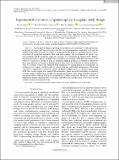Experimental evaluation of spatial capture–recapture study design
Abstract
A principal challenge impeding strong inference in analyses of wild populations is the lack of robust and long-term data sets. Recent advancements in analytical tools used in wildlife science may increase our ability to integrate smaller data sets and enhance the statistical power of population estimates. One such advancement, the development of spatial capture-recapture (SCR) methods, explicitly accounts for differences in spatial study designs, making it possible to equate multiple study designs in one analysis. SCR has been shown to be robust to variation in design as long as minimal sampling guidance is adhered to. However, these expectations are based on simulation and have yet to be evaluated in wild populations. Here we conduct a rigorously designed field experiment by manipulating the arrangement of artificial cover objects (ACOs) used to collect data on red-backed salamanders (Plethodon cinereus) to empirically evaluate the effects of design configuration on inference made using SCR. Our results suggest that, using SCR, estimates of space use and detectability are sensitive to study design configuration, namely the spacing and extent of the array, and that caution is warranted when assigning biological interpretation to these parameters. However, estimates of population density remain robust to design except when the configuration of detectors grossly violates existing recommendations.
Citation
Fleming , J , Grant , E H C , Sterrett , S C & Sutherland , C 2021 , ' Experimental evaluation of spatial capture–recapture study design ' , Ecological Applications , vol. Early View , e02419 . https://doi.org/10.1002/eap.2419
Publication
Ecological Applications
Status
Peer reviewed
ISSN
1051-0761Type
Journal article
Description
This research was funded by the National Institute of Food and Agriculture, accession 1009581. This is a contribution of the Salamander Population and Adaptation Network (SPARCnet) and contribution #767 of the U.S. Geological Survey’s Amphibian Research and Monitoring Initiative (ARMI).Collections
Items in the St Andrews Research Repository are protected by copyright, with all rights reserved, unless otherwise indicated.

